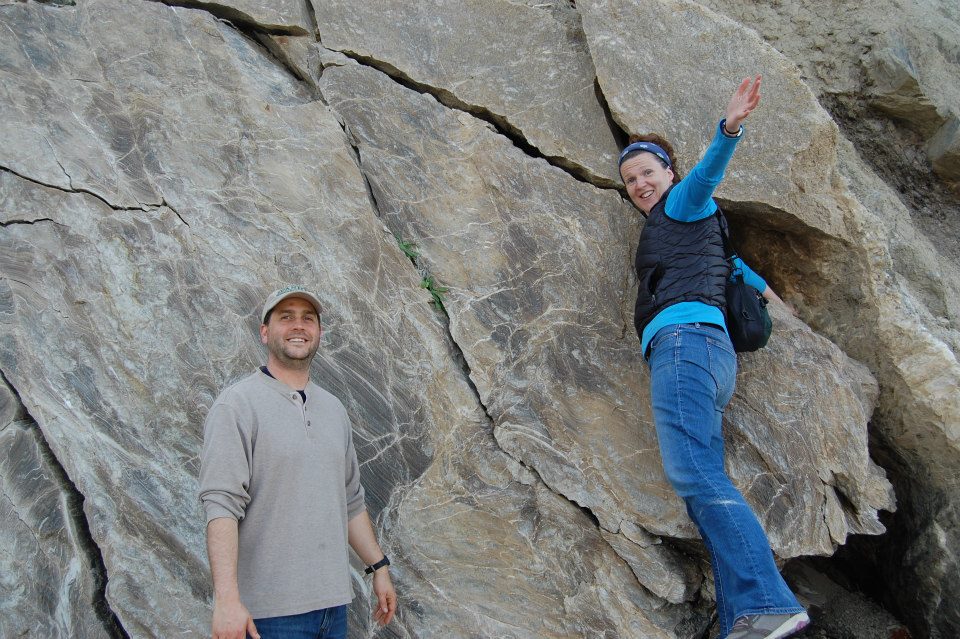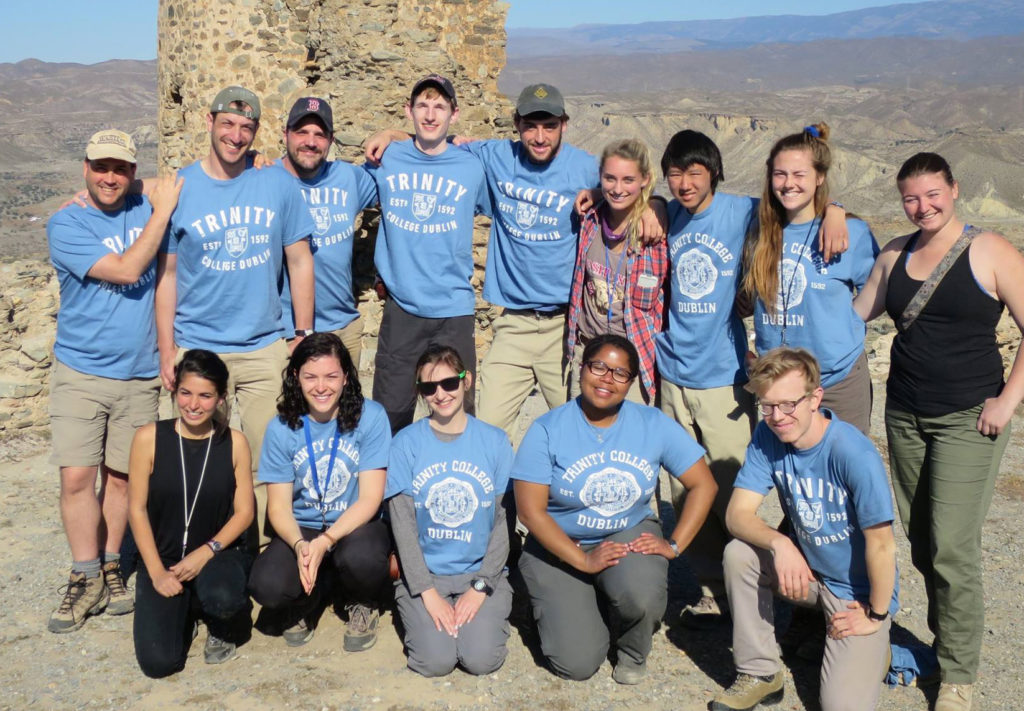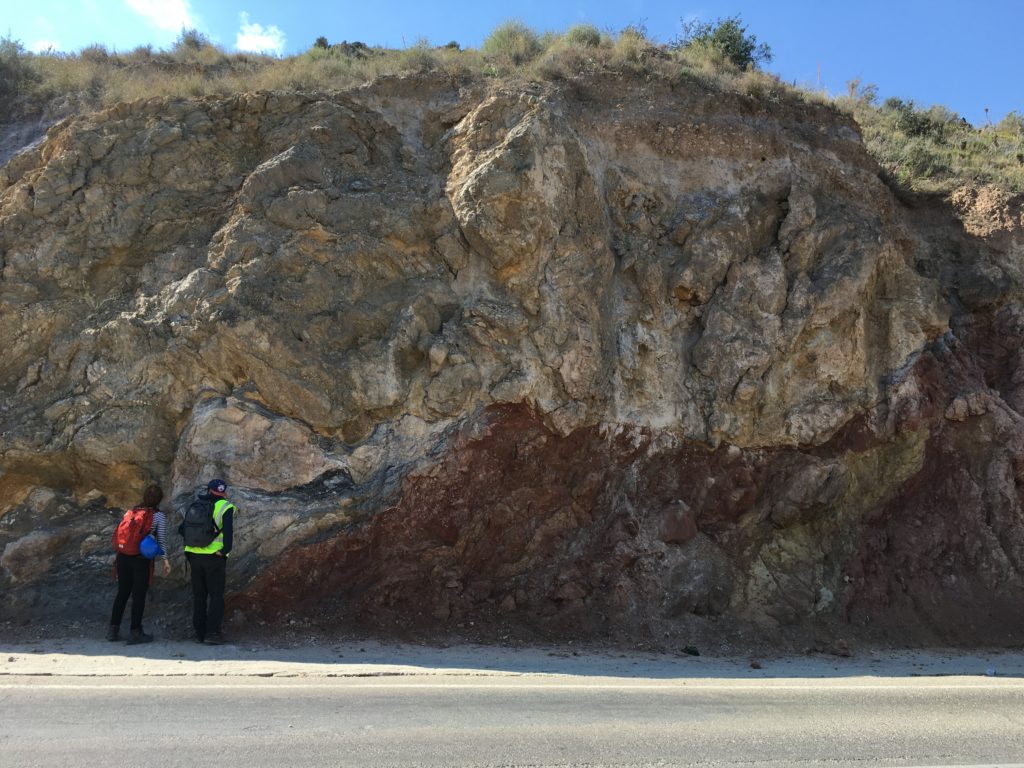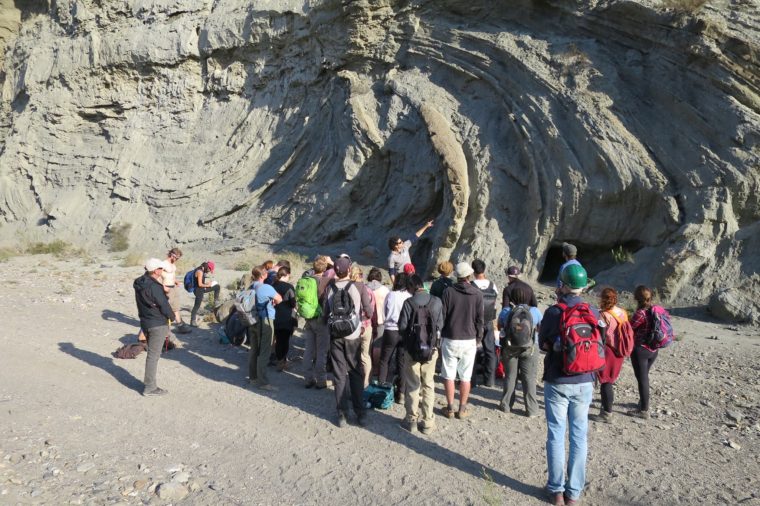Missouri, home to Washington University in St. Louis, has many attractions but ready access to unusual geology is not among them. Most of the rock is buried under thick glacial deposits (soil) and, even where it is visible, it is almost always limestone because the middle of the continent was, for millions of years, a vast seaway. As a result, the typical stratigraphic column in this part of the country is almost comically monotonous.
So geologists Phil Skemer, assistant professor; David Fike, associate professor; and Alex Bradley, assistant professor, all in earth and planetary sciences in Arts & Sciences, are on a mission to make sure Washington University’s geology students encounter a variety of rocks and rock formations in the field, as well as in the pages of textbooks.
And lately, this endeavor has taken an interesting turn. This spring, Washington University students went into the field with students who had much more field experience. The “old hands” were students from Trinity College, Dublin, under the tutelage of Catherine Rose and Quentin Crowley, both assistant professors of geology at Trinity. Rose had been the Steve Fossett Postdoctoral Fellow at Washington University from 2012-14.
The two groups traveled to southeastern Spain to examine millions of years of sedimentary deposits in basins formed as mountain ranges in the ancient Betic-Rif Arc pulled apart, stretching and dropping the crust between them. Among these sediments are thick layers of salt, deposited during the Messinian salt crisis, when the Mediterranean Sea repeatedly evaporated and re-flooded.
Zoe Lefebvre, a senior in geology, said that for many of the Washington University students, the first day in the field was the first time they had seen metamorphic rocks — and known what they were seeing. “Metamorphic rocks are not abundant in the flat-lying carbonates of the American mid-continent,” she said.
Monte Cole, a junior in environmental earth sciences, is frank about how little he knew. “With the exception of Zoe and Molly (Chaney), most of our people were kind of lost, but in a good way,” Cole said. “We soon got over not knowing what we were talking about and tried to learn as much as possible.”
Said Skemer: “Washington University students are very lab focused, quantitative and theoretical; Trinity College students are trained in the field. So the Washington University students know all sorts of detailed theory and chemistry and physics. The Trinity students are extremely good at identifying rocks and studying them in their natural environment.
“By putting these two groups together,” Skemer said, “we hoped that the Washington University students would learn from the Trinity students, and vice versa.”

“Before we went, the instructors told us the Trinity College students would be able to take a strike and dip in 15 seconds,” said Chaney, a senior in geophysics. “So we went thinking ‘Oh, we’re probably going to struggle compared to them.’
“And their instructors told them the Washington University students may not be as good as you in the field, but they have a very solid understanding of the theory,” Chaney said. “So both groups thought the other group was going to ‘wipe the floor’ with them.”
What happened?
“On our second day, we split into mixed groups,” Cole said, “and my group was supposed to look for evidence of paleoflow and paleoflow direction — the ancient flow direction of a river or stream.
“I’d never looked at sedimentary structures in the field, let alone learned how to reconstruct which direction a river was flowing in. But our (Trinity College) partners Roisin and Hazel were unbelievably helpful.
“I had to ask them to explain every second or third thing they said. Like, ‘What’s an imbrication?’ and ‘What do you mean we can assess based on clast size?’ It turned out to be quite fun to learn from peers,” Cole said. “It can be much harder to question professors who have PhDs and years of experience in the field.”

“By the end of the trip,” Chaney said, “both groups had a good sense of the other group’s strengths and weaknesses, so we tailored our questions to one another’s strengths. We would say, ‘Oh, I can’t tell what mineral this is. Would you take a look?’ And they would ask, ‘Why do you think we’re seeing carbonate here, when we were just walking through igneous rock?’
“By the end, I think we were asking one another more questions than we were asking the professors, which I thought was really nice,” Chaney said.
Asked to describe a moment of revelation, everyone mentions the same site.
“On maybe our second or third day,” Chaney said, “the instructors told us to walk along a road cut and tell them what we saw. So we were walking along writing down descriptions in our field notebooks, but after a while, we were thinking ‘What is going on here? Nothing’s changing. It’s just the same, boring basement rock over and over again.’
“Then we heard one of the Irish students screaming down the road, ‘Guys come around the corner. You have to see this!’
“So we ran down to the corner,” Chaney said, “and there was this huge fault. It was one of the coolest things I’ve ever seen.”

What was so exciting? The formation they were looking at had bent the rules of rigid-plate tectonics, and was doing something only nature would invent.
Cole thought it was stunning that he could time-travel by walking down a road cut. Chaney was trying to mentally reconstruct what kind of fault structure and movement could have produced this bizarre result. And Zoe said simply that it was a reminder — if one were needed — that rocks in the field are not the idealized ones found in textbooks.
Much discussion ensued. “Geology is not like math,” said Chaney, who also is earning a minor in mathematics. “In math, you have a single answer. In geology, there are competing theories. So everyone is always arguing, as they try to arrive at a coherent interpretation. of what they’re seeing”
The students also enjoyed listening to their professors argue. “It was fun to see that they were learning too,” Cole said.
